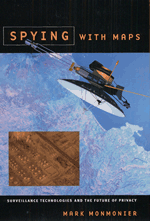Praise for the book:
"The author of many excellent books on cartography, Monmonier explores the ramifications of studying the physical and digital landscapes with tracking equipment.…We, whose compromised privacy provokes less joy, can at least be glad of Monmonier's incisive account of "dataveillance" and its implications for civil liberties."—Booklist
"New technologies raise profound questions about privacy and liberty, according to Mark Monmonier. In his new book, Spying with Maps, Mr. Monmonier explores thermal mapping, traffic cameras, credit-card databases, and other new tools that may make our lives uncomfortably transparent. He asks: Should "locational privacy" be understood as a fundamental right?"—Chronicle of Higher Education
"In this short, clever book—illustrated with dozens of maps, of course—Monmonier manages to cover the history of spy satellites, aerial photography for agriculture, the hot topic of using the Web and maps to track sex offenders, and much more. In each case, he shows the advantages created by cameras and computers, and the downside. So while traffic management software speeds drivers through crowded cities by timing the lights in real time, the same system can now give you a speeding ticket, and tomorrow it could record each trip you take.…Monmonier is refreshingly straightforward about his own research and life in Spying with Maps. For starters, he provides his address."—New Scientist
You Are Being Watched
Mark Monmonier
author of Spying with Maps: Surveillance Technologies and the Future of Privacy
![]()
Military intelligence, law enforcement, market research, and traffic engineering are making ever more innovative use of geographic data, satellite imagery, and location tracking. Ostensibly beneficial to national security, public safety, and the global economy, the growing diversity of geographic monitoring raises troubling questions about the societal consequences of geospatial snooping by Big Brother and a host of Little Brothers. To illustrate the danger of creeping acquiescence and the need for informed skepticism, "mapmatician" Mark Monmonier prepared a list of eleven types of surveillance that affect every ordinary citizen, or soon will.
- Credit-card purchases. Ignore the dot-coms and 1-800 retailers, and the record of your credit-card purchases reveals a lot about where you've been and when.
- Video cameras in stores and other public places. Smile! Depending on image quality and retention period, video surveillance could finger you as a suspect—or help identify the crook who swiped your stereo.
- Mail-order purchases, whether by mail, telephone, or the internet. The retailer who knows where to send your packages can easily send its catalogs to you-and your neighbors.
- Cell phones and other wireless devices. Because of a need to pinpoint E-911 calls, cellular providers can soon compile detailed histories of their customers' movements.
- Post Office change-of-address cards. By selling change-of-address information to publishers and advertisers, the Postal Service minimizes undeliverable junk mail and triggers special mailings to newcomers.
- Wages and other payments reported to the Social Security Administration or the Internal Revenue Service. For those of us not "working off the books," these agencies know how much you earn and where you work. What's more, IRS data averaged by Zip Code area help retailers locate new stores and target mailings.
- The decennial population census. Although the Census Bureau cannot disclose information on individuals or households, small area data reveal a lot about your neighborhood.
- Aerial photography (from aircraft or satellite). Overhead imagery can tell the local assessor whether you've put in a swimming pool or added a room to your house.
- Cadastral databases (ownership and tax assessment of real estate). Where property is taxed according to assessed value, your neighbors can look up your assessment and a bit more-including the purchase price.
- Medical records (physicians, health insurance firms, public health departments, etc.). Visit a doctor or a hospital, and the time, date, and diagnosis wind up in your insurer's database.
- Automatic toll-collection systems. In reducing wait time at tollbooths, E-Z Pass not only tracks cars but raises the possibility of billing drivers for exacerbating congestion during rush hour.
![]()
![]()
![]()
Mark Monmonier is Distinguished Professor of Geography at Syracuse University's Maxwell School of Citizenship and Public Affairs.
Copyright notice: ©2002 by Mark Monmonier. This text appears on the University of Chicago Press website by permission of the author. This text may be used and shared in accordance with the fair-use provisions of U.S. copyright law, and it may be archived and redistributed in electronic form, provided that this entire notice, including copyright information, is carried and provided that Mark Monmonier and the University of Chicago Press are notified and no fee is charged for access. Archiving, redistribution, or republication of this text on other terms, in any medium, requires the consent of Mark Monmonier.
Mark Monmonier
Spying with Maps: Surveillance Technologies and the Future of Privacy
©2002, 250 pages, 7 halftones, 58 line drawings
Cloth $25.00 ISBN: 0-226-53427-8
Paper $16.00 ISBN: 0-226-53428-6For information on purchasing the book—from bookstores or here online—please go to the webpage for Spying with Maps.
See also:
- Monmonier's list of ten risky places, a web feature for Cartographies of Danger: Mapping Hazards in America
- Spotting Bushmanders, a web feature for Bushmanders and Bullwinkles: How Politicians Manipulate Electronic Maps and Census Data to Win Elections
- An excerpt from Air Apparent: How Meteorologists Learned to Map, Predict, and Dramatize Weather by Mark Monmonier
- All our books by Mark Monmonier
- Our catalog of Cartography titles
titles- Other excerpts and online essays from University of Chicago Press titles
- Sign up for e-mail notification of new books in this and other subjects
